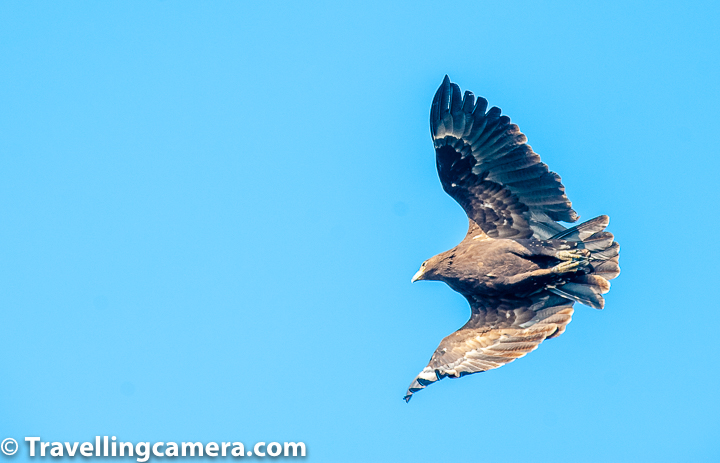 |
| Ibises and Herons |
We have already talked about the birds belonging to the order passeriforme, or the songbirds, at Keoladeo National Park. Apart from these, there were several other birds that we saw. We have already talked in details about most of them. Click on the following links to access all our posts about the birds at Keoladeo National Park:
In this post we will talk in details about the non-passerine birds we have not covered so far, while also mentioning the ones that we have already discussed.
 |
| Rose-Ringed Parakeet |
These were by far the friendliest birds at the Keoladeo National Park and at times we could sense that they were feeling neglected because despite their bright colours and gregariousness tourists were more interested in clicking the waterbirds. This particular Rose-Ringed Parakeet stayed in this position for minutes to allow us to photograph it well. As did the one in the below photographs.
 |
| Rose-Ringed Parakeet |
Rose-Ringed Parakeet is a medium-sized parrot belonging to the order Psittaciformes. The adult male of the species has a rose-colored ring around its neck, which is lacking or less pronounced in females or younger males. This is a herbivorous bird that is very noisy in the wild, with a call that sounds like a loud, out-of-tune squawk. No wonder then that it is not a songbird :). This bird, when raised as a pet, can be taught to speak.
 |
| Smaller Waterbirds |
Smaller waterbirds such as the kingfishers, sandpipers, coots, moorhen, swaphen etcetra were a common sighting in Keoladeo National Park. These birds belong to various orders such as Coraciiformes, Charadriiformes, and Gruiformes. These birds were the sidekicks to the larger waterbirds at Bharatpur Bird Sanctuary.
 |
| Ibises and Herons |
Ibises and Herons both belong to the order Palecaniformes and are often found in close proximity to each other near waterbodies. These birds are some of the most popular subjects for photographers at Bharatpur Bird Sanctuary. Indeed, a heron standing in meditative silence next to waterbodies does cut a pretty picture.
 |
| Storks and Cormorants |
Storks and Cormorants (also the Oriental Darter) belong to the orders ciconiiformes and suliformes respectively. These were the center of attraction at the Keoladeo National Park, at least when we visited it in November 2018. It is because of their sheer numbers that you cannot ignore these birds. We were lucky enough to spot the Painted Stork, the Woolly-Necked Stork, and the Black-headed Stork in the Sanctuary. We were also extremely fortunate to spot all the three types of Cormorants - Little, Indian, and Great - during our visit. The cherry on the top was a very nice sighting of the oriental darter hunting and then drying its wings on the branches close to the waterbodies.
 |
| Greater Coucal |
The Greater Coucal belongs to the order Cuculiformes. This is the order to which other cuckoo birds such as the Koel and the Hawk Cuckoo also belong. Unlike the Koel and the Cuckoo, however, the Greater Coucal is a weak flier and is often found walking on the ground, hunting insects. Its call is a resonant low hooting, which is considered ominous in some cultures. The Greater Coucal is a common resident in the Indian Subcontinent and unlike its close relative, is non-parasitic.
 |
| Birds of Prey |
In the Keoladeo National Park, we saw several birds of prey, large and small. We saw the Egyptian Vulture, the Spotted Owlet, Western Marsh Harrier, Black-shouldered Kite, and Dusky Eagle Owl. These birds, often ignored because the other avians are more colorful, talkative, or attention seeking, are the very spirit of the jungle. Their quiet presence seems to maintain order in what would otherwise have been mayhem. May be I say too much, but birds of prey are often denied the attention they deserve.
 |
| Common Hoopoe |
The Common Hoopoe or the Eurasian Hoopoe is a beautiful bird that is often found wandering about on muddy grounds. It belongs to the order Bucerotiformes, though was earlier classified under coraciiformes, the order to which the Kingfishers and bee-eaters also belong. Hoopoe is also often also often clubbed with woodpeckers. Hoopoes are in general considered to be friends of humans because they feed on several insects that are considered pests and their pupae. Hoopoes dwell in tree cavities made by woodpeckers or other birds.
 |
| Hawk Cuckoo |
The Common Hawk-Cuckoos belong to the order Cuculiformes and is also known as the brain-fever bird or the papeeha. Some people feel that its beautiful, melodious call that echoes around the valleys sounds like "brain fever", which is why it has been given this unfortunate name of the brain-fever bird. However, to people who stay near groves of trees or green tropical areas, its call is a melodious reminder of nature's music during the day and late into the night as well.
 |
| Green Bee-eater |
The Green Bee-Eater also appears in our post about the songbirds. This is because the bird is classified as a near passerine bird, and we are not sure what that means. Nevertheless, we love this beautiful bird so we thought we would include it in both the birds. The Green Bee-eater is a common sight in rural as well as urban landscapes and is often a nuisance for the bee-keepers. Males and Females are alike in appearance.
This is our last post on Keoladeo National Park that talks about the birds in the sanctuary. There will be one more post that talks about the park in general and then we will close this series. It has been an educating experience observing and documenting these birds. And we hope to continue increasing our knowledge about our avian companions.


.jpg)
Comments